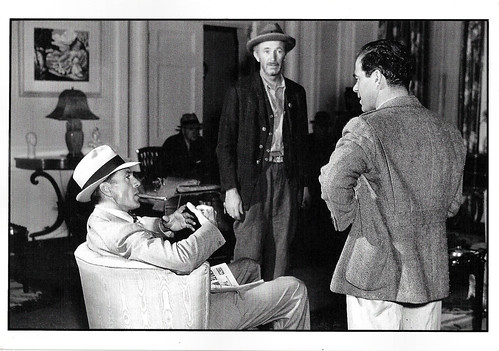
French postcard in the Entr'acte series by Éditions Asphodèle, Mâcon, no. 004/3. Collection: B. Courtel / D.R. Gary Cooper, Walter Brennan, and Frank Capra on the set of Meet John Doe (Frank Capra, 1940). Caption: Conference between Gary Cooper, Water Brennan and director Frank Capra.

French postcard by Edition a la Carte. Photo: Filmhistorisches Bildarchiv Peter W. Engelmeier. Claudette Colbert and Clark Gable in It Happened One Night (Frank Capra, 1934).
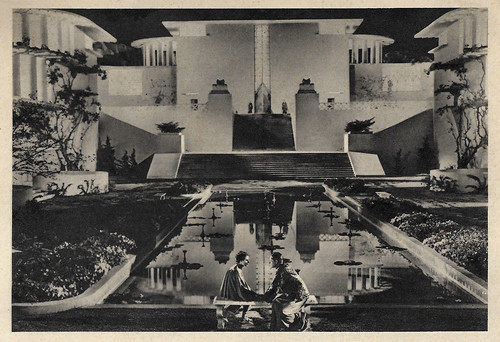
Italian postcard by Vecchioni & Guadagno, Roma. Photo: Columbia EIA. Ronald Colman and Jane Wyatt in Lost Horizon (Frank Capra, 1937). The Italian title was orizzonte perduto.
Developing into a comedy specialist
Francesco Rosario ‘Frank’ Capra was born in 1897 in Bisacquino, a village near Palermo in Sicily, Italy. He was the youngest of seven - surviving - children of the fruit picker Salvatore Capra and his wife Rosaria ‘Sara’ née Nicolosi. In 1903, his family moved with to Los Angeles, California, when he was five years old. The family had to spend the thirteen-day voyage across the Atlantic in cheap steerage because of a lack of money, and Capra later described the misery there as one of his worst life experiences.
His father worked as a fruit picker, as he had done in Italy. While attending school, Frank had to earn money on the side as a paperboy for ten years. Capra finished high school after ten years and studied chemical engineering at the Throop Institute, later the California Institute for Technology. During World War I, he served in the army, but contracted Spanish flu and was discharged.
After the war, he began working as an extra in films, after which he gained experience editing and directing short films. At the age of 24, Capra made the 32-minute documentary La Visita Dell'Incrociatore Italiano Libya a San Francisco. It documents the visit of the Italian naval vessel Libya to San Francisco and the reception given to the ship's crew by San Francisco's L'Italia Virtus Club. This was his first contact with film, although the short documentary did not bring him any attention or success.
In 1923, he married Helen Howell. The following year, he was hired by Hal Roach as a screenwriter for Our Gang films. Capra wanted to be a director, but Roach refused, after which Capra resigned. He started working for Mack Sennett in 1925. Sennett had him write screenplays for films starring Harry Langdon. Langdon's comic character was characterised by boundless slowness, naivety and innocence, which is why he was usually unable to cope with the big, hard world. Capra, who was developing into a comedy specialist, played a part in Langdon's rise to become one of Hollywood's most successful comedians in the mid-1920s. After Landon left Sennett and moved to First National to make feature films, Capora was also sacked by Sennett.
He was hired as a gag writer by Harry Langdon, working on Langdon's first First National feature-length film, Tramp, Tramp, Tramp (Harry Edwards, 1926). It did well at the box office, but the film had run over budget, and director Harry Edwards was sacked. For his next picture, The Strong Man (Frank Capra, 1926), Langdon promoted Capra to director, boosting his salary to $750 per week. The film was a hit, but trouble was brewing because Langdon was increasingly believing his own press. Langdon was compared to Charlie Chaplin, Harold Lloyd and Buster Keaton. After the shooting of Long Pants (Frank Capra, 1927), Capra and Langdon had a falling out and the successful duo parted ways. Capra made another silent comedy film for First National, For the Love of Mike (Frank Capra, 1927), about three bickering godfathers—a German, a Jew, and an Irishman — in which Claudette Colbert, who was still virtually unknown at the time, also had a role. This now-lost film was met with poor reviews and Capra did not receive another contract with First National.
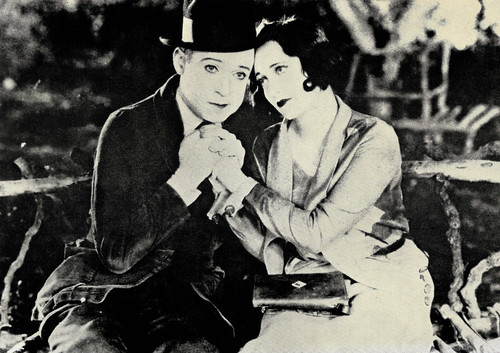
French postcard by François Nugeron, Paris. Photo: Collection Snark. Harry Langdon and Joan Crawford in Tramp, Tramp, Tramp (Harry Edwards, 1926), based on a screenplay by Frank Capra. The French film title was Plein des bottes.

Vintage collectors card. Photo: Columbia. Jack Holt, Lila Lee and Ralph Graves in Flight (Frank Capra, 1929).
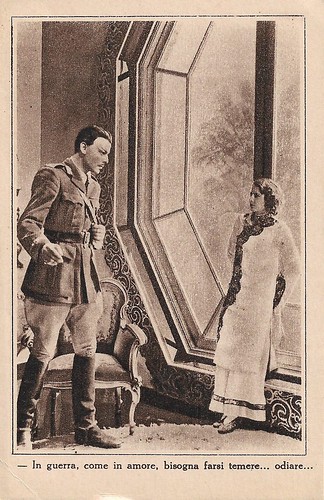
Italian postcard by S.A. Arte della Stampa, Roma. Photo: Columbia. Nils Asther and Barbara Stanwyck in The Bitter Tea of General Yen (Frank Capra, 1933). Caption: In war, as in love, you need to be feared... hated... The card wears an ink stamp for the Cinema Italia in Genoa. The Italian release title was L'amaro tè del generale Yen.

British postcard. Photo: Columbia. Clark Gable as Peter in It Happened One Night (Frank Capra, 1934).
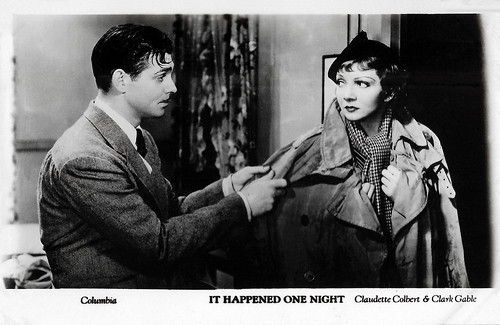
British postcard in the Film Shots Series by Film Weekly. Photo: Columbia. Clark Gable and Claudette Colbert in It Happened One Night (Frank Capra, 1934).
Capra's name above the title
In 1928, Frank Capra was hired by producer Harry Cohn to help his film studio Columbia Pictures produce new, full-length feature films, to compete with the major studios. At the time, Columbia was one of the so-called Poverty Row film studios in Hollywood, but Columbia wanted to gain in importance and size and catch up. Capra made a total of twenty films for Columbia Pictures, nine of them in his first year. Most of Capra's nine films in 1928 turned out to be very successful, so Cohn increased his salary from USD 1,000 per film to an annual salary of USD 25,000. Cohn also put Capra's name above the title of his films, a first for the movie industry. Capra's first sound film was the drama The Younger Generation (Frank Capra, 1929), a part-talkie starring Ricardo Cortez. In this drama, Cortez plays the son of a Jewish family in New York who denies his Jewish roots to remain in favour with his girlfriend. At the end of the 1920s, sound film arrived in Hollywood. Capra welcomed this. In the production of his first sound films, his engineering studies were an advantage. He quickly became accustomed to the technical innovations of sound film.
He started to work with cameraman Joseph Walker and they worked together on a total of 18 films, Capra also regularly hired screenwriter Robert Riskin who wrote the witty and sharp dialogue in many of Capra's films. The two became Hollywood's most acclaimed director/writer team. After notable successes such as the adventure film Flight (Frank Capra, 1931) and above all the comedy Platinum Blonde (Frank Capra, 1931), which significantly advanced Jean Harlow's career, Capra made the comedy Lady for a Day (Frank Capra, 1933). The 75-year-old May Robson plays a poor apple seller who disguises herself as a lady. Despite the rather unusual leading actress, the film was nominated for four Oscars, including in the Best Director category for Capra. Although he did not win, Lady for a Day is considered Capra's first big hit, and it was also Columbia's first film to be nominated for an Oscar for Best Film.
The following year saw his first major milestone. The romantic comedy It Happened One Night (1934), starring Clark Gable and Claudette Colbert, was a huge success. It Happened One Night was the first film to win the five major Oscars, namely Best Picture, Best Direction (for Capra), Best Male Lead (for Gable), Best Female Lead (for Colbert) and Best Screenplay (for Riskin). Claudette Colbert plays a spoilt millionaire heiress who flees from her father to a snobbish lover. Along the way, she gets to know the misery of ordinary people in the Great Depression but also falls in love with a down-to-earth reporter (Clark Gable). Despite this actual comic plot, Capra also shows the problems of the average American citizen during the Great Depression. It Happened One Night is now regarded as the founding film of the screwball comedy par excellence and propelled Columbia Pictures into the ranks of the major Hollywood studios.
In the following years, Frank Capra made a series of comedies, such as Mr Deeds Goes to Town (1936), Lost Horizon (1937), You Can't Take It with You (1938) and Mr Smith Goes to Washington (1939). All these films were nominated for several Oscars, including for Best Picture. Many of these films were about ‘the little man who fought against the system’. In Mr Deeds Goes to Town (Frank Capra, 1936), Gary Cooper plays a fortune-card poet, a kindly, naïve country bumpkin who inherits a million-dollar fortune. He does a lot of good with his money before his money-grubbing and fraudulent lawyers try to declare him insane. Capra won his second Oscar for Best Director for Mr Deeds Goes to Town. The adventure film Lost Horizon (Frank Capra, 1937) with Ronald Colman, was based on a utopian novel by James Hilton. Lost Horizon differed from Capra's previous films and was shot for the then-high sum of 1.5 million US dollars. The film was set in an exotic, beautifully utopian valley in the Himalayas and the film's sets were therefore extremely elaborate.
On 5 May 1936, Capra, now the highest-paid director in Hollywood, hosted the 1936 Academy Awards. Capra was honoured with his third Oscar for Best Director in five years for the comedy You Can’t Take It With You (Frank Capra, 1938), which also won the Oscar for Best Film of the Year. Jean Arthur and James Stewart star as a pair of young lovers whose very different families - one of tough businessmen, the other of alternative eccentrics - get to know each other. Capra also cast Stewart in many of his later films. In 1939, Capra made one of his best-known films, the political satire Mr Smith Goes to Washington (Frank Capra, 1939), again starring Arthur and Stewart. Capra made Stewart a Hollywood star with his films. In Mr Smith Goes to Washington (1939), Capra's patriotism is evident, showing the individual in the democratic system fighting against rampant corruption in politics. Upon its release, the film was popular with critics and audiences, but the US ambassador to Great Britain at the time, Joseph P. Kennedy, asked Columbia boss Harry Cohn that the film should not be shown in Europe. Capra and Cohn ignored the criticism.

Italian postcard by Vecchioni & Guadagno, Roma. Photo: Columbia EIA. Ronald Colman, Jane Wyatt and Margo in Lost Horizon (Frank Capra, 1937). Art director Stephen Goosson won an Academy Award in 1938 for this film. The convent of Shangri-La was built in Streamline Moderne style at the Columbia lot in Burbank.

Italian postcard by Vecchioni & Guadagno, Roma. Photo: Columbia EIA. Still from Lost Horizon (Frank Capra, 1937). Art director Stephen Goosson won an Academy Award in 1938 for this film.
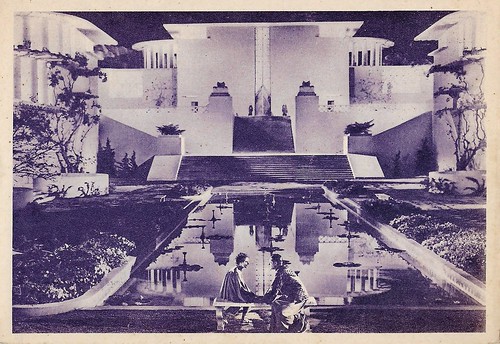
Italian postcard by Vecchioni & Guadagno, Roma. Photo: Columbia EIA. Ronald Colman and Jane Wyatt in Lost Horizon (Frank Capra, 1937).
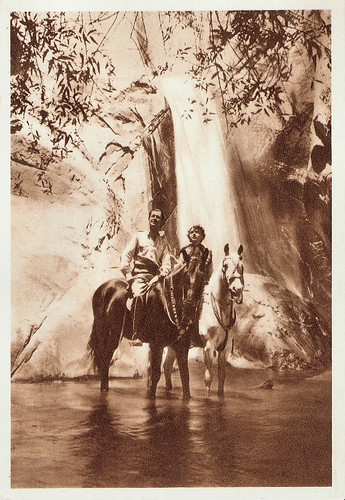
Italian postcard by Vecchioni & Guadagno, Roma. Photo: Columbia EIA. Ronald Colman and Jane Wyatt in Lost Horizon (Frank Capra, 1937).

Italian postcard by Vecchioni & Guadagno, Roma. Photo: Columbia EIA. Ronald Colman in Lost Horizon (Frank Capra, 1937).
Why we fight
Frank Capra left Columbia and made his next two films at Warner Bros. His first film there was Meet John Doe (Frank Capra, 1941). Gary Cooper plays a former baseball player who wanders the country without work or money before he is proclaimed "John Doe" by news reporters and mutates into a hero of the masses. Released shortly before the USA entered the Second World War, Meet John Doe again shows patriotic traits. Also, the film contains a message against fascism: an unscrupulous and obviously fascist industrialist with dictatorial intentions uses John Doe for his own purposes and wants to become president.
Capra also made the comedy Arsenic and Old Lace with Cary Grant, which was not released until 1944. The black comedy then received excellent reviews and was also successful with audiences. Just four days after the attack on Pearl Harbor on 7 December 1941, Capra joined the US Army with the rank of major and gave up his Hollywood career for the time being.
Over the next few years, he was involved in shooting numerous war documentaries for America in the service of the United States Army Pictorial Service. His seven-part, award-winning documentary series Why We Fight (1942-1945) explained why the US soldiers went to war for their country and their goals. For the first film in the series, Prelude to War (1942), Capra received an Oscar. Capra saw the series as a response to Leni Riefenstahl's Nazi propaganda film Triumph des Willens/Triumph of the Will (1935) and it was a great success.
With Walt Disney's help, he also produced a total of 28 three- to five-minute black-and-white cartoons about ‘Private Snafu’, which were used for educational purposes in the armed forces. Colonel Frank Capra was awarded the Army Distinguished Service Medal. After the war, he started Liberty Pictures with William Wyler and George Stevens. His best-known film, the Christmas classic It's a Wonderful Life (Frank Capra, 1946) with James Stewart and Donna Reed, was a big flop in cinemas, but later found its audience on television. Except for It's a Wonderful Life, other post-war films could not reach the level of his pre-war films, and the filmmaker struggled to reach new audiences. In 1961, he made his last film, Pocketful of Miracles (Frank Capra, 1961) with Glenn Ford and Bette Davis. In 1971, he published his autobiography ‘The Name Above the Title’. He was also involved in documentaries.
In 1991, Frank Capra died in his sleep of a heart attack in La Quinta, California. He was 94 years old. He was interred at Coachella Valley Public Cemetery in Coachella, California. Capra married the actress Helen Howell in 1923 and they divorced in 1928. In the same year, he married Lucille Warner. The marriage, which ended in 1984 with Warner's death, produced one daughter and three sons - one son died as an infant. Another son was the film producer Frank Capra Junior, whose son is the assistant director Frank Capra III. Frank Capra was nominated six times for the Oscar for Best Direction, eventually winning it three times, for It Happened One Night (in 1935), Mr Deeds Goes to Town (in 1937) and You Can't Take It with You (in 1939). For the first and last, he also won the Academy Award for Best Picture. In 1947, he won a Golden Globe for directing It's a Wonderful Life.
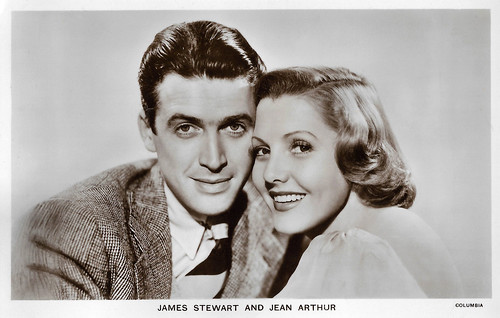
British postcard in the Film Partners Series, London, no. P 265. Photo: Columbia. James Stewart and Jean Arthur in You Can't Take It with You (Frank Capra, 1938).

French postcard in the Collection Télérama, la mémoire du cinéma, no. 128 by Editions Zreik, Paris. Image: French affiche by Osso for Mr. Deeds Goes To Town (Frank Capra, 1936). The French film title was L'extravagant Mr. Deeds.
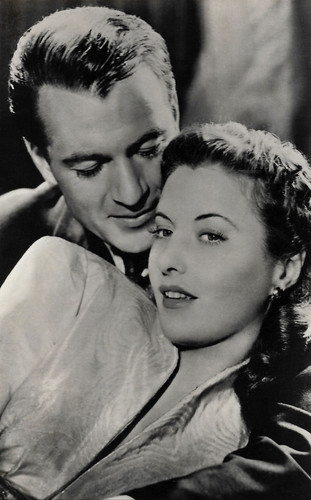
Spanish postcard by SOBE, no. 499. Sent by mail in 1949. Photo: Barbara Stanwyck and Gary Cooper in Meet John Doe (Frank Capra, 1941).

American postcard in The Ludlow Collection by Classico San Francisco, no. 136-308. James Stewart, Donna Reed, Beulah Bondi, Carol Coombs, Karolyn Grimes and Thomas Mitchell in It's a Wonderful Life (Frank Capra, 1946).
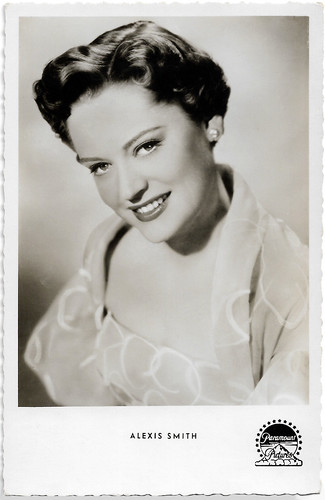
West German postcard by Kunst und Bild, Berlin W., no. A 362. Photo: Paramount. Alexis Smith in Here Comes the Groom (Frank Capra, 1951).
Sources: Jon C. Hopwood (IMDb), Wikipedia (Dutch, German and English) and IMDb.
No comments:
Post a Comment